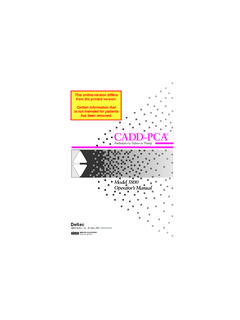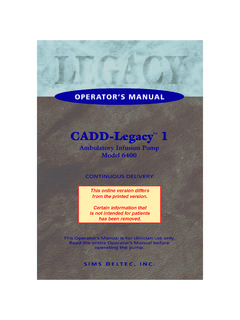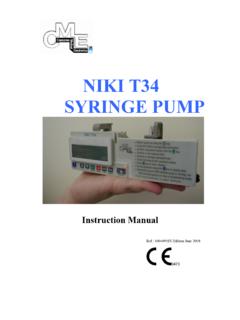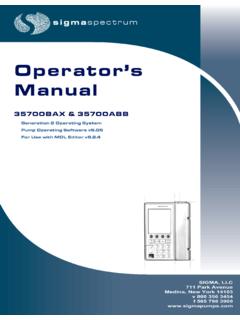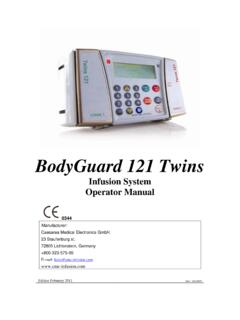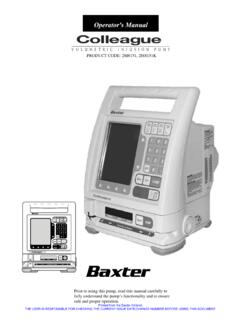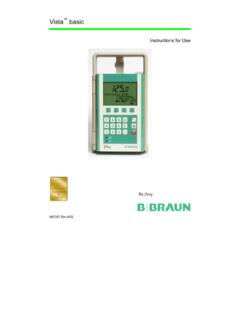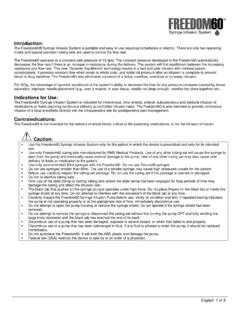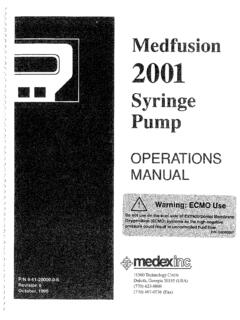Transcription of 19885 3933-51D Manual, Legacy PCA, 2000-03
1 IPROOF (LR #3086), 2000 -03-15 3933-51D Cover, Legacy PCA SIMS DELTEC, controlled ANALGESIAThis Operator s manual is for clinician use the entire Operator s manual beforeoperating the S MANUALCADD- Legacy PCAA mbulatory Infusion PumpModel 63003933-51D Cover, Legacy PCA12/7/00, 11:29 AM1iiPROOF (LR #3086), 2000 -03-15 3933-51D Cover, Legacy PCA This manual pertains only to the Deltec CADD- Legacy PCA (PatientControlled analgesia ) Model 6300 ambulatory infusion pump. This pumpcan be programmed to deliver medication at a constant rate and/or toallow delivery of a bolus dose to a specified time interval. This manual isintended for clinician use only. Do not permit patients to have access tothis manual . The pump has three security levels designed to limit patientaccess. Do not disclose the pump s security codes or any other informationthat would allow inappropriate access to programming and issue date of this Operator s manual is included on the back cover forthe clinician s information.
2 In the event one year has elapsed between theissue date and product use, the clinician should contact SIMS Deltec, see if a later revision of this manual is AssistanceIf you have comments or questions concerning the operation of theCADD- Legacy pump, please call the appropriate number given calling, please specify your pump s software module. This informa-tion is located on the start-up staff at Deltec is available to help clinicians twenty-four hours a daywith the programming and operation of the CADD- Legacy DistributionEuropean RepresentativeSIMS Deltec, Graseby Grey Fox RoadWD2 4LG UKSt. Paul, Minnesota 55112 +44 (0)1923 246434 CADD, Medication Cassette Reservoir design, CADD- Legacy , and Medication Cassette areSIMS trademarks. (The symbol indicates it is registered in the Patent and TrademarkOffice and certain other countries.)
3 DURACELL is a registered trademark of Duracell Inc. EVEREADY ENERGIZER is aregistered trademark of Union Carbide Corp. Super Sani-Cloth is a registered trademark ofProfessional Disposables, products described are covered by one or more of the following: U. S. Patent ,559,038; 4,565,542; 4,650,469; 5,364,242; 5,531,697; 5,538,399; 5,540,561; 5,564,915;5,567,119; 5,567,136; 5,647,854; 5,695,473; Japanese Patent No. 2034590; EuropeanPatent No. 0182502; other patent(s) pending, foreign patent(s) Cover, Legacy PCA3/16/00, 6:39 PM2iiiPROOF (LR #3086), 2000 -03-15 3933-51D Cover, Legacy PCA Read this entire Operator s manual before operating theCADD- Legacy ambulatory infusion to properly follow warnings, cautions, and instructionscould result in death or serious injury to the This Operator s manual should be used by clinicians only. Donot permit patients to have access to this manual , as the informa-tion contained would allow the patient complete access to allprogramming and operating functions.
4 Improper programmingcould result in death or serious injury to the patient. For those patients who are likely to be adversely affected byunintended operations and failures, including interrupted medi-cation or fluid delivery from the device, close supervision andprovision for immediate corrective action should be provided. If the pump is used to deliver life-sustaining medication, anadditional pump must be available. The pump is not to be used for delivery of blood or cellularblood products. If the pump is dropped or hit, inspect the pump for damage. Donot use a pump that is damaged or is not functioning Customer Service to return a pump for service. Use of a syringe with the CADD Administration Set may resultin UNDER-DELIVERY of medication. Syringe function can beadversely affected by variations in plunger dimension and lubric-ity, which can result in greater force required to move the syringeplunger.
5 A syringe plunger will lose lubrication as it ages and, asa result, the amount of under-delivery will increase which couldon occasion, be significant. Therefore, the type of medicationand delivery accuracy required must be considered when using asyringe with the CADD must regularly compare the volume remaining in the3933-51D Cover, Legacy PCA3/16/00, 6:39 PM3ivPROOF (LR #3086), 2000 -03-15 3933-51D Cover, Legacy PCA syringe to the pump s displayed values such as RES VOL andGIVEN in order to determine whether under-delivery of medica-tion is occurring and if necessary, take appropriate action. System delivery inaccuracies may occur as a result of backpressure or fluid resistance, which depends upon drug viscosity,catheter size, and extension set tubing (for example, microboretubing). Do not administer drugs to the epidural space or subarachnoidspace unless the drug is indicated for administration to thosespaces.
6 To prevent infusion of drugs that are not indicated for epiduralspace or subarachnoid space infusion, do not use administrationsets that incorporate injection sites. If a Medication Cassette Reservoir, CADD Extension Set orCADD Administration Set is used for drug delivery into theepidural or subarachnoid space, clearly differentiate them fromthose used for other routes of infusion, for example, by colorcoding, or other means of identification. When the Air Detector is turned off, the pump will not detect airin the fluid path. Periodically inspect the fluid path and removeany air to prevent air embolism. You must use a CADD Extension Set with an Anti-SiphonValve or a CADD Administration Set with either an integral orAdd On Anti-Siphon Valve to protect against unregulated gravityinfusion that can result from an improperly attached cassette. When the Upstream Occlusion Sensor is turned off, the pumpwill not detect occlusions upstream (between pump and fluidcontainer).
7 Periodically inspect the fluid container for decreasingvolume, inspect the fluid path for kinks, a closed clamp, or otherupstream obstructions. Upstream occlusions could result inunder- or non-delivery of Cover, Legacy PCA3/16/00, 6:39 PM4vPROOF (LR #3086), 2000 -03-15 3933-51D Cover, Legacy PCA Do not disclose to the patient the pump s security codes or anyother information that would allow the patient complete accessto all programming and operating functions. When you enter a new Dose Lockout time or Doses per Hourvalue, any lockout time in effect will be cleared. A Demand Dosecould be requested and delivered immediately upon starting thepump, resulting in over-delivery. Do not use rechargeable NiCad or nickel metal hydride (NiMH)batteries. Do not use carbon zinc ( heavy duty ) batteries. Theydo not provide sufficient power for the pump to operate prop-erly. Always have new batteries available for replacement.
8 If power islost, non-delivery of drug will occur. If the pump is dropped or hit, the battery door tabs may not use the pump if the battery door or tabs are damagedbecause the batteries will not be properly secured; this may resultin loss of power and non-delivery of drug. If a gap is present anywhere between the battery door and thepump housing, the door is not properly latched. If the batterydoor becomes detached or loose, the batteries will not be prop-erly secured; this could result in loss of power and nondelivery ofdrug. Close the fluid path tubing with the clamp before removing thecassette from the pump to prevent unregulated gravity infusion. For detailed instructions and warnings pertaining to MedicationCassette Reservoir or CADD Administration Sets, please referto the instructions supplied with those products. Frozen medication must be thawed at room temperature not heat the Medication Cassette Reservoir in a microwaveoven as this may damage the medication, the Medication Cas-sette Reservoir, or cause Cover, Legacy PCA3/16/00, 6:39 PM5viPROOF (LR #3086), 2000 -03-15 3933-51D Cover, Legacy PCA Attach the cassette (the part of the Medication Cassette Reser-voir or CADD Administration Set that attaches to the pump)properly.
9 An improperly attached or detached cassette couldresult in unregulated gravity infusion of medication from thefluid container or a reflux of blood. Do not prime the fluid path with the tubing connected to apatient as this could result in overdelivery of medication or airembolism. Ensure that the entire fluid path is free of all air bubbles beforeconnecting to the patient to prevent air embolism. Prior to starting infusion, inspect the fluid path for kinks, aclosed clamp, or other upstream obstructions, and remove anyair to prevent air embolism. Exercise care when using the Clinician Bolus function. Sincethere are no limits on the frequency of delivering a bolus, andsince the amount of bolus can be set as high as 20 ml (or the mgor mcg equivalent), you should not permit the patient to becomefamiliar with the procedure for giving a Clinician Bolus. To prevent the patient from accessing the Clinician Bolus func-tion, do not let the patient know the Clinician Bolus Do not operate the pump at temperatures below +2 C (36 F) orabove 40 C (104 F).
10 Do not store the pump at temperatures below -20 C (-4 F) orabove 60 C (140 F). Do not store the pump with the MedicationCassette Reservoir or CADD Administration Set attached. Usethe Protective Cassette provided. Do not expose the pump to humidity levels below 20% or above90% relative Cover, Legacy PCA3/16/00, 6:39 PM6viiPROOF (LR #3086), 2000 -03-15 3933-51D Cover, Legacy PCA Do not store the pump for prolonged periods with the batteriesinstalled. Do not immerse the pump in cleaning fluid or water or allowsolution to soak into the pump, accumulate on the keypad, orenter the battery compartment. Do not clean the pump with acetone, other plastic solvents, orabrasive cleaners. Do not expose the pump to therapeutic levels of ionizing radia-tion. Do not expose the pump directly to ultrasound. Do not use the pump in the vicinity of magnetic resonanceimaging (MRI) equipment.
